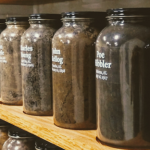Originally published here.
Thanks to stalwart cluster members James Cummings and Audrey Verma, as well as first-time visitor Katy Lamb, for a fantastic cluster meeting on Weds 14th February. James, Audrey and Katy talked from their research projects about the vastly different capacities of a range of social actors to imagine alternative liveable futures through reflections on pasts that were narrated in terms of loss, pain – and also joy.
Memorials and futures of Equal Justice: Katy is an UG student in the Combined Honours programme and joined us to talk about recent fieldwork in Montgomery, Alabama. Katy won Ncl university funding to conduct research relating to the Equal Justice Initiative’s Legacy Museum: From Enslavement to Mass Incarceration. Katy’s work helped us to think about the power of commemoration and especially of material objects to rework the past in the present, t o make the invisible visible. Here the aim is to inject a new and uncomfortable narrative into the history and historiography of the US and into its contemporary cultural life, adding something distinct to recent debates which have often focused on the removal of Confederate statues and markers.
o make the invisible visible. Here the aim is to inject a new and uncomfortable narrative into the history and historiography of the US and into its contemporary cultural life, adding something distinct to recent debates which have often focused on the removal of Confederate statues and markers.
Katy talked movingly about the museum’s planned National Memorial for Peace and Justice which features displays of soil taken from lynching sites in the museum (seen in the photo here which Katy took during her visit). Katy is working with ideas about the connotations of soil as dirtying and its etymology which is related to wallowing; but also about its links with growth, grit, life-support and renewal. Katy’s reflections on soil, memory and imagined futures also evoked ideas about digging up the past both as a metaphor and as the physical labour involved in locating and recovering these lost sites.
Katy has been drawing on these readings to make sense of this material: Forsdick C (2015) Travel, slavery, memory: thanatourism in the French Atlantic. Postcolonial Studies 8790(March): 1–15. Buzinde CN and Santos CA (2008) Representations of slavery. Annals of Tourism Research 35(2): 469–488. Ebron PA (1999) Tourists as Pilgrims: Commercial Fashioning of Transatlantic Politics. American Ethnologist 26(4): 910–932.
